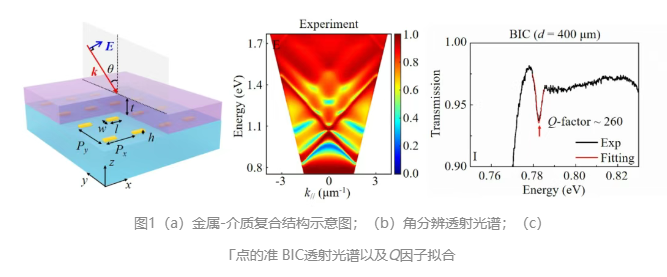31
2025
-
07
Reusable high-Q plasmon metasurface
Author:
Surface plasmon Surface Plasmons, SPs Due to their ability to confine electromagnetic field energy to a deep subwavelength scale, surpassing the diffraction limit, surface plasmons (SPs) have become an important platform for enhancing light-matter interactions. However, various loss mechanisms in plasmonic systems severely restrict performance improvement. On the one hand, inherent losses in metallic materials lead to irreversible dissipation of electromagnetic field energy; on the other hand, losses caused by defects such as surface roughness and grain boundary scattering during nanofabrication further exacerbate mode decay. The uncontrollability of these loss mechanisms , has led researchers to consider how to improve the quality factor (Q factor) of plasmon modes by reducing radiative losses. Q factor.
BICs and SLRs are commonly used methods to reduce the radiative loss of plasmon modes, achieving precise control of the radiation channel through topological protection in momentum space and coupling with diffraction channels, respectively. Meanwhile, in - hybrid systems of metal and dielectric, the introduction of photonic modes can redistribute the near-field energy of the above two modes, , thus further reducing the inherent loss of the system.
As shown in the structural schematic diagram 1 ( a ), this hybrid structure consists of a two-dimensional array of gold nanorods and a polyvinyl alcohol ( PVA ) film, with an array size of 200 μ m × 200 μ m ,得益于 PVA Due to its water solubility and easy reconstruction, different thicknesses of PVA films can be repeatedly removed and spin-coated on the same structure, thus enabling PVA research on the influence of thickness on plasmon modes Q Q 。 The results show that while maintaining plasmon near-field enhancement, the introduction of photonic modes can significantly improve BICs and SLRs 的 Q factor.
In addition, the team built its own infrared angle-resolved transmission system, using fiber optic point light collection in the spectral plane. The angle-resolved spectrum of one sample is shown in Figure 1 ( b ). By reducing the light collection diameter of the optical fiber, it is possible to improve the resolution of the spectral plane, and measure 的q-BIC的 Q the 260 Q 1 ( factor to , as shown in Figure c Q ). The team pointed out that by increasing the array size and using coherent light source excitation, the
Q BICs factor is expected to be further improved. However, the existing array size is close to the pixel size, and has the application potential in the fields of meta-display, spatial light modulator, etc. SLRs 的 Q Finally, the team conducted a comparative study of the BICs 的 Q and SLRs values measured under the same sample and the same test conditions. The results show that the Q Q BICs factor can reach four times that of SLR 的 Q , therefore, in obtaining high Q Q

factor, has a greater advantage; however, Q Q factor is less sensitive to angle changes. These characteristics indicate that these two types of high SLR and BIC modes have their own advantages and are suitable for different application scenarios. BIC Corresponding author Professor Jinwei Shi said: SLR 的 Q “ BIC The low SLR and BIC These results are often obtained under different experimental parameters and conditions, making direct comparison difficult. Furthermore, conducting such experiments requires the production of a large number of samples, which is costly. Using reusable overlays to change the sample patterns is a more economical and practical approach. From an application perspective, samples with limited size and incoherent illumination are more consistent with real-world applications, in which case BIC will all transform into quasi BIC , and the resolution of the spatial frequency spectrum will be greatly affected the experimental measurement results. Considering these factors comprehensively, we found that BIC 的 Q values are indeed higher than SLR , however SLR 的 Q values are more robust to angular changes, therefore different modes should be selected according to different application needs to further enhance the effect of light-matter interaction. ”
The team will subsequently utilize this composite surface's ability to support multiple high Q resonant modes in the field of light-matter interaction, such as enhanced second and third harmonic emission 、 , on-chip optical parametric oscillators and parametric conversion, angle-sensitive photoluminescence and lasers 、 , spatial filters, etc., to continue application research.
LATEST NEWS
2025-12-17
Beijing Institute of Technology Review: Infrared Detectors for In-Memory Sensing and Computing
2025-12-17
High-performance III-V family infrared detectors
Since the advent of infrared detectors in the 1940s, their technological framework has undergone leapfrog development, with significant expansions in both device types and performance.

